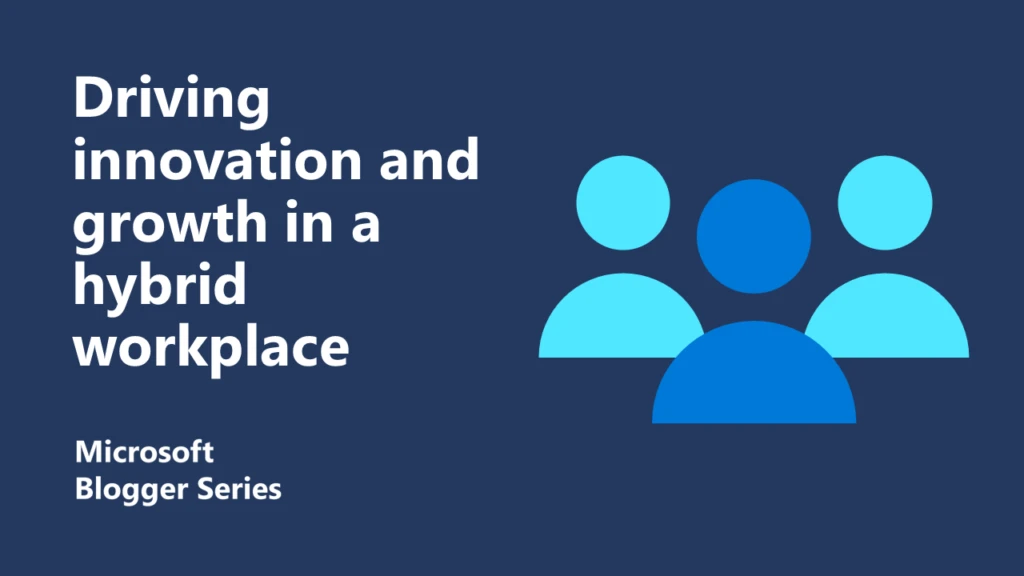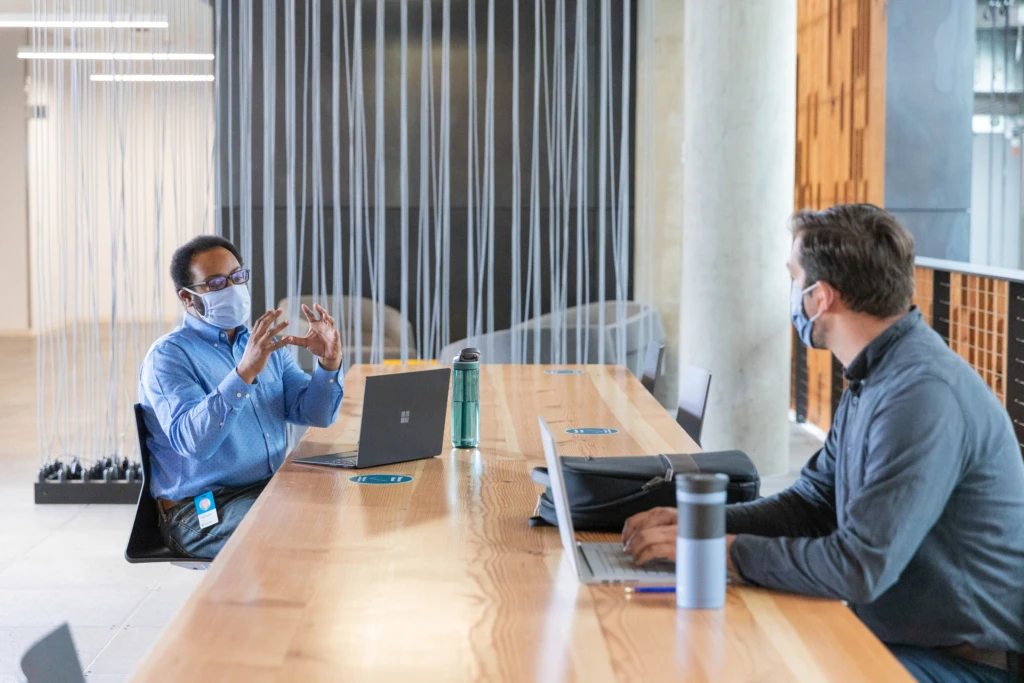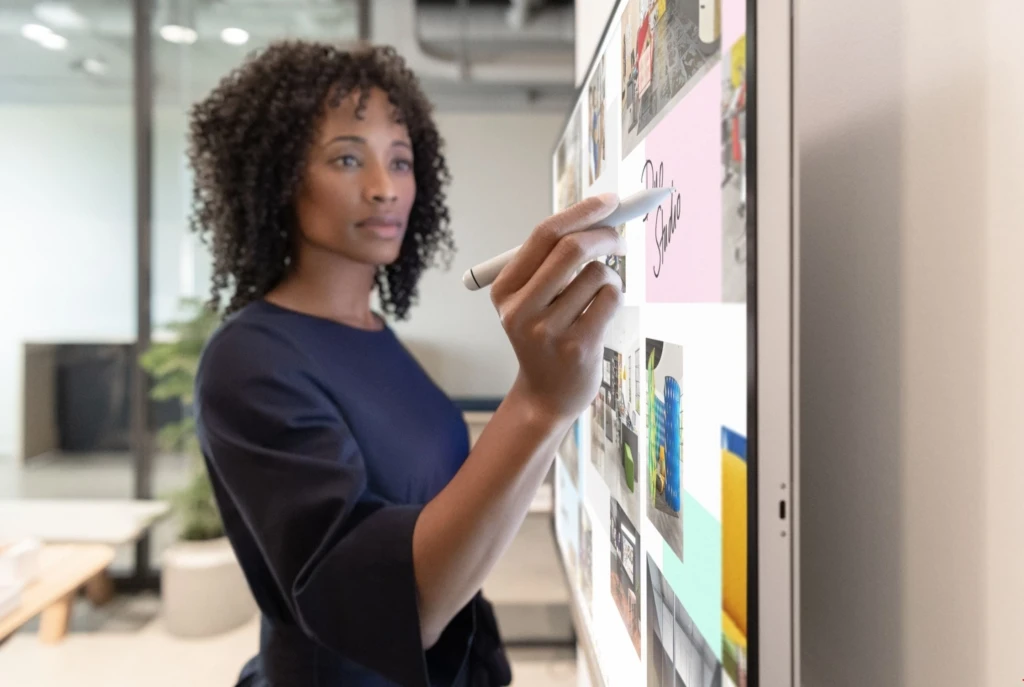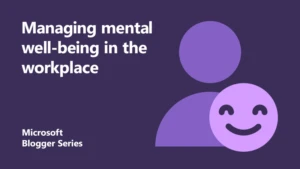
How a hybrid workplace can drive innovation and growth
 2020 has been a watershed moment for workplace modernisation across all businesses. It’s accelerated the uptake of many modern ways of working that were already underway in some organisations. Flexible working practices, remote work, and distributed teams are now core topics for business resilience in the new hybrid workplace.
2020 has been a watershed moment for workplace modernisation across all businesses. It’s accelerated the uptake of many modern ways of working that were already underway in some organisations. Flexible working practices, remote work, and distributed teams are now core topics for business resilience in the new hybrid workplace.
“We’ve seen two years of digital transformation in two months.”
Satya Nadella, CEO.
At Microsoft, we spent the last few months learning from our customers and studying how we’re all adapting to the challenges of today. What’s clear is that we see the world going through three distinct phases:
- Responding to the immediate impact of COVID-19.
- Recovering and how organisations are getting back on track and functioning in the new normal.
- Re-imagining the very nature of their operations through innovations born of necessity from the previous two phases.
These phases will help build resilience and power the UK economic and societal recovery. We need to stay secure, be agile, and empower our people to achieve more.
How organisations responded
COVID-19 led to a digital first response as firms quickly enabled their employees to work remotely. We saw Microsoft Teams use generating over 5 billion meeting minutes in a single day during the first quarter of 2020. Legal & General uses Teams to allow contact centre employees to work from home. This meant that customers were still able to get help from the financial services business during critical times. Our collective response has shifted technology conversations to the boardroom. But it has mainly been focussed on replicating the office at home. However, is this truly the optimal way for organisations to operate in the ‘new normal’?

A chance to adapt and re-imagine
With great change comes great opportunity. This is a chance to adapt and re-imagine your business strategy and the role that technology will play in it. And not just in your response, but over the next two phases by focussing on:
- Culture: Managing talent, investing in skills, and equipping all employees with the right tools.
- Leadership: Managing the new interplay between employees and technology to optimal effect.
- Technology: Supporting new communications and workflows that empower employees.
How to build a hybrid workplace

Phase 2 is where we will see the true emergence of a hybrid workplace. For organisations, a key challenge will be developing a sound strategy that meets employee’s new expectations on the way they work.
A recent survey we did found that 72 percent of UK employees and managers want to work from home at least part time. But there’s still a need for human interaction – 62 percent feel less connected to their team when they were working from home. Therefore, it’s important to recognise that not everything can be done virtually. And indeed, not everyone can work remotely, especially in the case for industries such as retail and manufacturing.
Take Nationwide, for example. In June, employees made 2.5 million video calls on Teams. This prompted the bank to build on this technology, and now they are working to integrate Teams into all their meeting rooms to ensure everyone can take part in meetings.
Patrick Eltridge, Chief Operating Officer at Nationwide, said: “Having Teams in place prior to COVID-19 has ensured we could react to lockdown rules very effectively as we prepared the organisation for new ways of working. Teams has enabled us to convene large groups of people in a way that isn’t possible in a meeting room. It’s not a contingency service for us but something we will continue to build on in the future.”
Leaders who empower their people, places, and processes with digital technology will easily transform their businesses into hybrid workplaces, recover faster, and emerge stronger than those who do not. To build an effective hybrid workplace, organisations need to focus on three things — leadership, culture, and technology.
Leadership
It’s important to have a strategy that enables people to work effectively with colleagues regardless of location. Key to this is a shared purpose and a sense of cohesion. This strategy should be driven from the top and include all teams.
Equip and trust your people to build and use digital capabilities that suit them. Provide support from a mental wellbeing perspective – help people find ways of working and connections that work best for them in this new world of work. AI can be used to help employees make better decisions and focus on higher-value tasks, whilst also boosting inclusivity and sparking creativity.
Culture
Your people are the heartbeat of your business. Leaders must ensure people have the right skills and technology to succeed and the ability to innovate wherever and however they work. They must meet the needs of every individual embracing diversity in all forms. An effective culture gives people not only the means to be productive but the drive to innovate, adapt, and progress.
Support the workplace with technologies that suit remote, office, and frontline workers while keeping them secure. Organisations need an integrated and intelligent approach to security, powered by the cloud and AI. Customer trust is everything. Therefore, ensuring employees have access to the information they need, wherever they are, whilst maintaining security, privacy, and regulatory compliance is vital.
Technology
Key to the hybrid workplace is the right technology platform that allows strategic direction and a strong culture. Microsoft Teams helps organisations give people a single tool to work together no matter where they are, creating a seamless workflow that improves both individual and organisational performance.
Use technology to rebuild and re-imagine process and workflows, breaking up traditional siloes to reconfigure support for how the business and its people now operate. By utilising cloud technologies, firms can gather insights and organise content to identify trends and determine the best course of action in ways that are simply not possible via traditional means. Mott MacDonald is a global engineering, management, and development consultancy that is using cloud technologies to innovate. Their coastal engineering team has been developing a new approach to climate resilience, using flood behaviour predictions as a model simulation for hurricane resilience. Using Azure, they’ve reduced their job completion time and resource costs by 30 percent.
Re-imagine processes and strategies for the hybrid workplace
What excites me the most is the potential we all have to re-imagine business strategies for the long term and create competitive advantage for the future. This is our chance to help the UK as a whole emerge stronger.
I believe this is a great opportunity for organisations to re-imagine the role of the workplace. It will no longer be a traditional desk-based office, but a drop-in place for collaboration and connection. From in-person meetings with customers, to creative workshops and team building exercises. But beyond the makeup of the workplace itself lies the broader opportunity to innovate and re-imagine business processes and strategies.
Hybrid workplace: A springboard for future growth and competitive advantage
 When we think about the four elements of digital transformation, we tend to think about empowering employees, optimising operations, transforming products, and engaging customers.
When we think about the four elements of digital transformation, we tend to think about empowering employees, optimising operations, transforming products, and engaging customers.
Much of the transformation in recent months has been focussed on empowering employees. But we have a great opportunity to go a step further. To be truly innovative.
“Tech intensity is the key to business resilience. Organisations that build their own digital capability will recover faster.”
– Satya Nadella
The hybrid workplace can deliver innovation at speed
What’s clear is that uncertainty is the new normal. And when we can’t predict we need to get ahead. Remember innovation at speed is not a choice. You need data to create new business models, new distribution channels, and new ways to survive and thrive. This data and your customer’s data needs proactive protection. In this new era of hybrid organisations, you must protect every employee, every device, every network – wherever they are, at all times.
At the heart of the hybrid workplace are your people. And this goes beyond supporting remote work and new safety processes. To sum it up, giving your employees the right skills, tools, and culture can empower your people to be more creative, more productive, and more collaborative, while ensuring no one is left behind.
This opportunity implores us to focus on the things that really matter. It is our chance to reimagine the very essence of the way we work, and the role technology has in creating agile and resilient organisations in the future.
Find out more
Read more: Changing the way we think about remote working
Download the eBook: Four ways to enable the Anywhere Office
Download the report: AI skills in the UK
Join the conversation at Envision
Digital technology is changing not just how organisations operate but how leaders lead. Join us at Envision, where executives across industries come together to discuss the challenges and opportunities in this era of digital disruption. You’ll hear diverse perspectives from a worldwide audience and gain fresh insights you can apply immediately in your organisation.
Connect with leaders across industries to get relevant insights on leadership in the digital era.
About the author
 Nick leads the Modern Work and Security business for Microsoft UK and has a passion for helping individuals and organisations to become more productive. Personal and organisational productivity is high on the list for every leader right now; Nick and his team dedicate their working hours to the role that Microsoft technologies can play as part of a business transformation journey.
Nick leads the Modern Work and Security business for Microsoft UK and has a passion for helping individuals and organisations to become more productive. Personal and organisational productivity is high on the list for every leader right now; Nick and his team dedicate their working hours to the role that Microsoft technologies can play as part of a business transformation journey.





